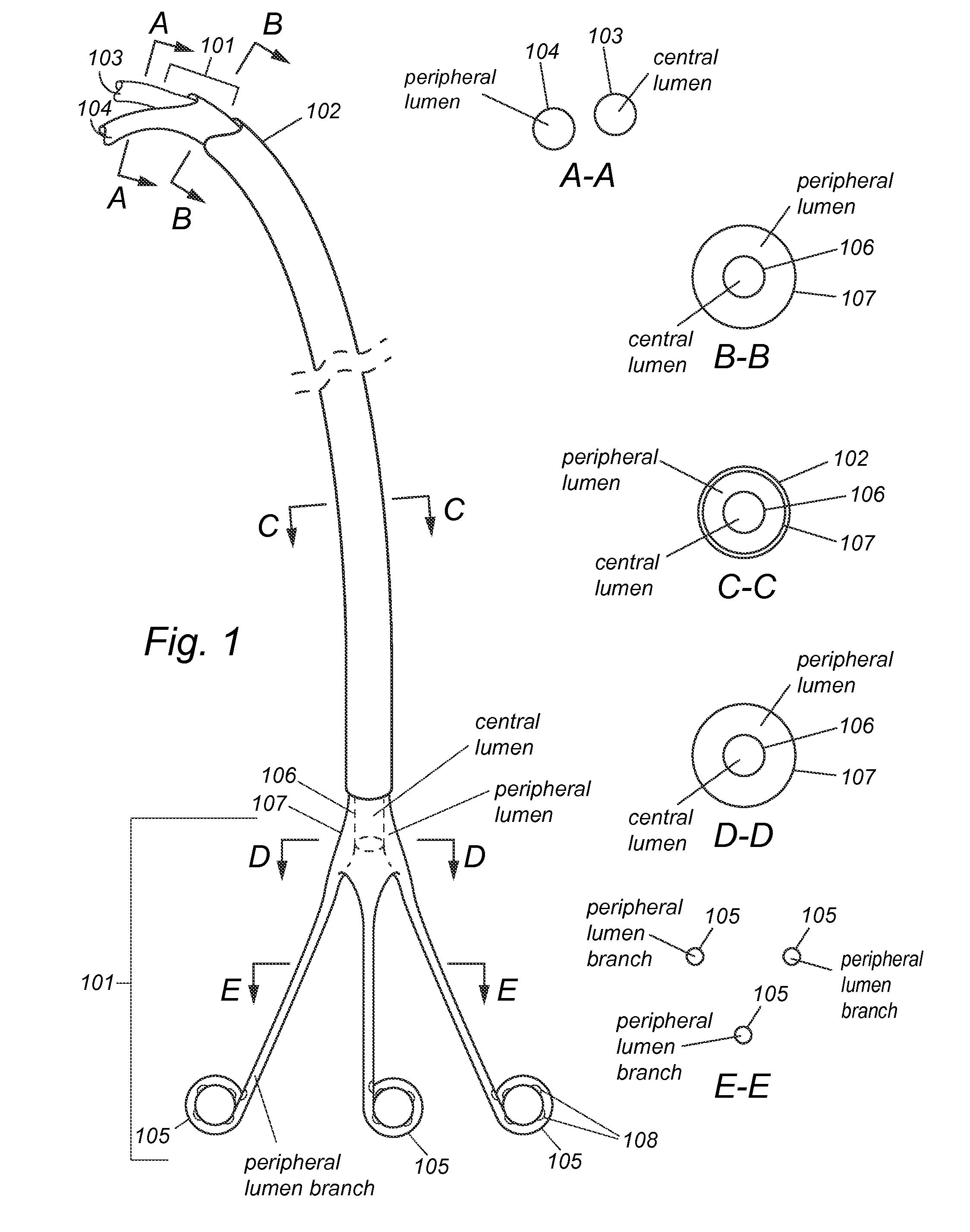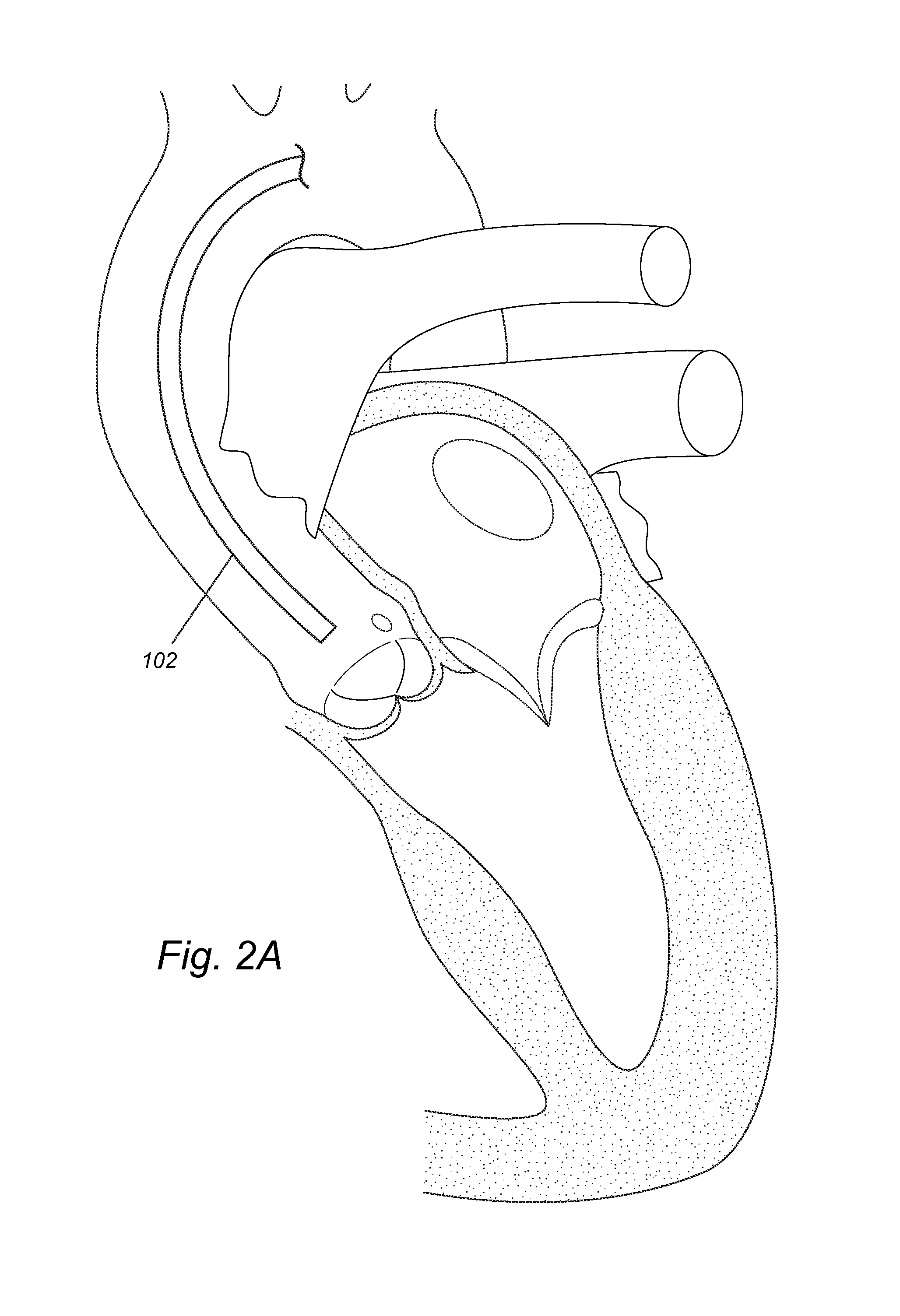Pigtail for optimal aortic valvular complex imaging and alignment
a complex imaging and alignment technology, applied in the field of aortic valve complex imaging and/or transcatheter aortic valve replacement, can solve the problems of unreliability of imaging methods, increased risk of prolonged or permanent damage, need for further medical attention or dialysis, etc., and achieve the effect of facilitating precise rotational positioning
- Summary
- Abstract
- Description
- Claims
- Application Information
AI Technical Summary
Benefits of technology
Problems solved by technology
Method used
Image
Examples
example 1
[0029]A non-limiting example of a device according to the present disclosure is shown in FIG. 1. The catheter 101 is covered by an outer sheath 102. The length of the catheter 101 may be but is not limited to about 90-300 cm depending on the precise application. The diameter of the catheter may be but is not limited to about 4-23 Fr. The length of the outer sheath 102 may be but is not limited to about 80-290 cm. The diameter of the outer sheath 102 may be but is not limited to about 5-24 Fr. The catheter 101 may have an interior wall 106 and an exterior wall 107. In some embodiments, a central lumen is defined by the interior wall 106 at the center of the catheter 101. The central lumen may be used for inserting another instrument (e.g., a guidewire, a catheter, and a pressure sensor). For example, the catheter 101 may be advanced over a guidewire in the central lumen to be guided to reach the sinotubular junction or other internal structure, or a guidewire may be inserted in the c...
example 2
[0036]A non-limiting example of a method according to the present disclosure is shown in FIGS. 2A-E. In some embodiments, standard steps may be performed, including induction of anesthesia (local or general), sterile preparation and other necessary and standard steps in a transcatheter and percutaneous operation (for example, incising and / or pre-closing an artery, threading and / or removing a guidewire, and inserting and / or withdrawing a catheter). FIG. 2A illustrates an outer sheath 102 that has been maneuvered to reach the sinotubular junction of a subject via transfemoral, transaxillary / subclavian, or transaorticroute. Some routine steps are not shown or described here. For example, a guidewire may be mounted to the outer sheath's distal end to guide the outer sheath through the subject's vasculature system. Then, a catheter 101 may be inserted into the outer sheath 102. As the outer sheath 102 encloses the distal portion of the catheter 101, the three distal branches 105 are flat...
example 3
[0041]Another non-limiting example of the method is shown in FIGS. 3A-E. After induction of anesthesia, a caregiver may perform sterile preparation and other necessary and standard steps in a transcatheter and percutaneous operation (for example, incising and / or pre-closing an artery, threading and / or removing a guidewire, and inserting and / or withdrawing a catheter). As illustrated in FIG. 3A, an outer sheath 102 may be maneuvered to reach the sinotubular junction of a subject via transfemoral, transaxillary / subclavian, or transaortic route. Some routine steps are not shown or described here. For example, a guidewire may be mounted to the outer sheath's distal end to guide the outer sheath through the subject's vasculature system. A catheter 101 may then be inserted into the outer sheath 102 and advanced to the distal end of the outer sheath 102. As illustrated in FIG. 3B, while the outer sheath 102 encloses the distal portion of the catheter 101, the three distal branches 105 (in ...
PUM
 Login to View More
Login to View More Abstract
Description
Claims
Application Information
 Login to View More
Login to View More - R&D
- Intellectual Property
- Life Sciences
- Materials
- Tech Scout
- Unparalleled Data Quality
- Higher Quality Content
- 60% Fewer Hallucinations
Browse by: Latest US Patents, China's latest patents, Technical Efficacy Thesaurus, Application Domain, Technology Topic, Popular Technical Reports.
© 2025 PatSnap. All rights reserved.Legal|Privacy policy|Modern Slavery Act Transparency Statement|Sitemap|About US| Contact US: help@patsnap.com



